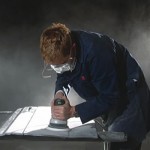Motor Vehicle Repair – Harmful Dusts Inhalation and Dermatitis risks
Exposure to dust from sanding vehicle body fillers can cause damage to the respiratory system and irritation to the skin that may lead to dermatitis or other skin conditions. Dust can irritate and damage the eye. Appropriate control measures are required to manage the inhalation and dermatitis risk.
Most vehicle body fillers consist of thermosetting unsaturated polyester in a solvent which is mixed with a reactive hardener. Hardeners are usually skin irritants and some are strong skin sensitisers. Both the filler and hardnerer can cause dermatitis. Styrene and methacrylates are often found in these mixtures and have powerful odours. Both styrene and methacrylates can affect the nervous system.
Check the safety data sheet for these chemicals and if you find them, try to find alternative less harmful filler products. Glass fibre fillers can irritate the skin.
To minimise the number of people exposed to dust and vapours, separate the body filling and preparation area away from other work.
When using powered sanding tools and sander with built in extraction should be used. Portable local exhaust ventilation may be appropriate, positioning the local extraction close to the work is necessary.
Where it is necessary to remove large excesses of filler the use of large coarse hand files should be considered
Even if the dust does not contain specific harmful substances (such as styrene or methacrylates) you should keep dust to a minimum as the quantity generated can be damaging to health.
Where necessary, personal protective equipment such as disposable overalls should be sued to help prevent dust build up on clothing. Suitable gloves (eg nitrile gloves) should also be considered as fine dust will clog up the pores in the skin and they would also protect the hands when wet sanding.
In some situations respiratory protective equipment may be required, a P2 dust mask is usually adequate.
For information on air monitoring and exposure assessment click here.
For further information on how we can assist you with noise assessment services call our office or use our contacts page to forward a request for further information.










